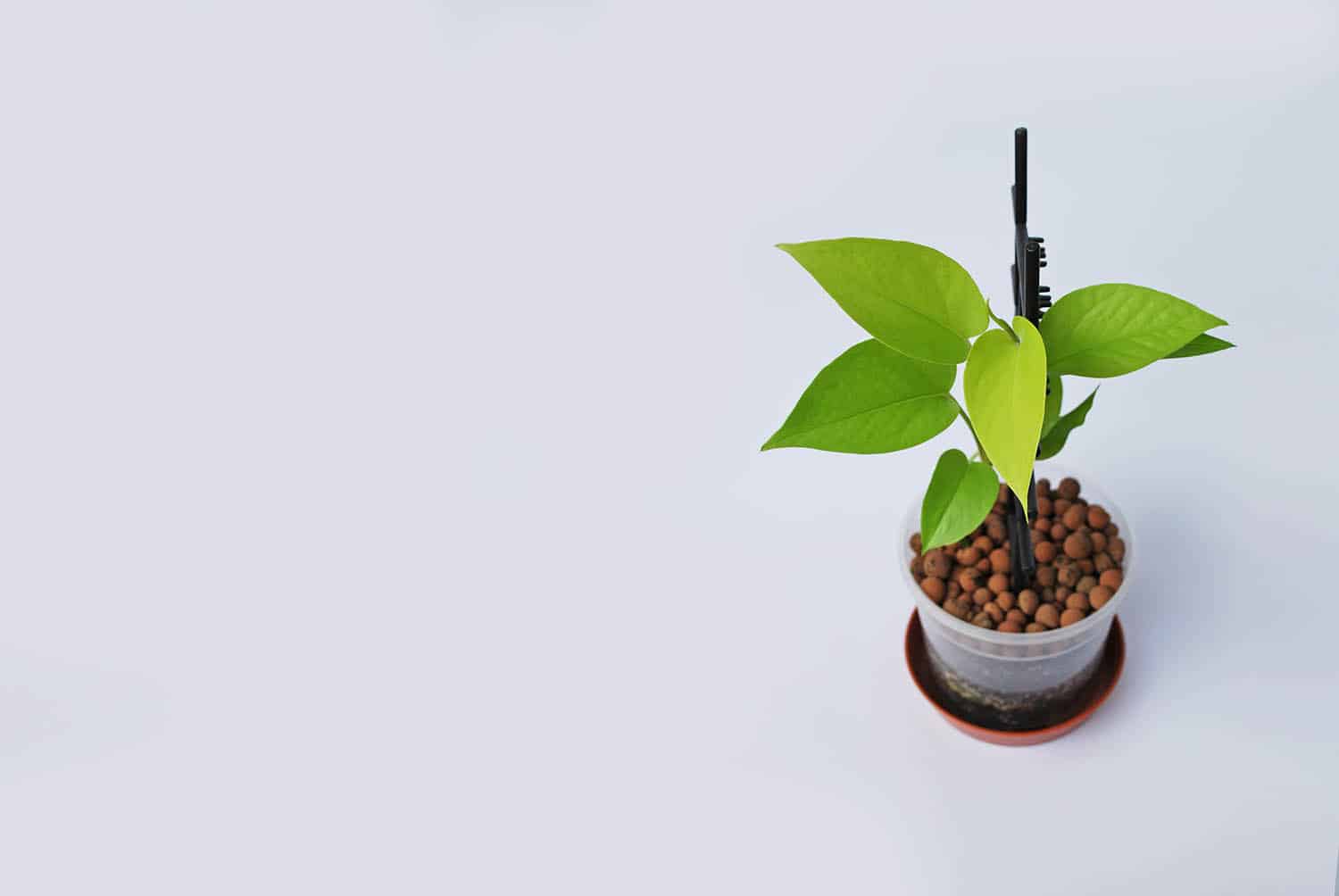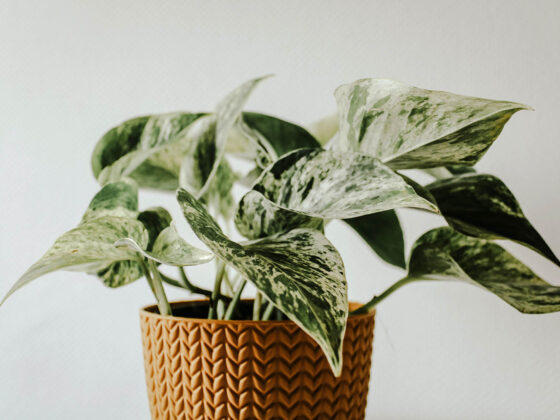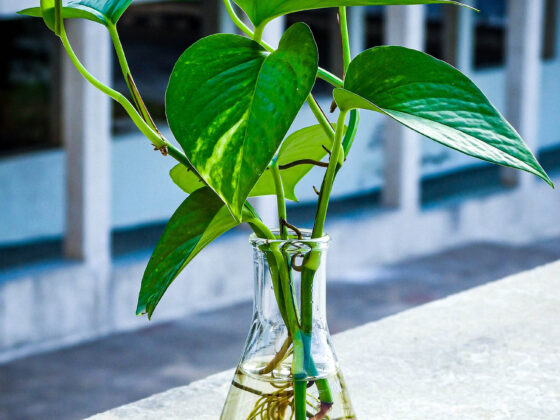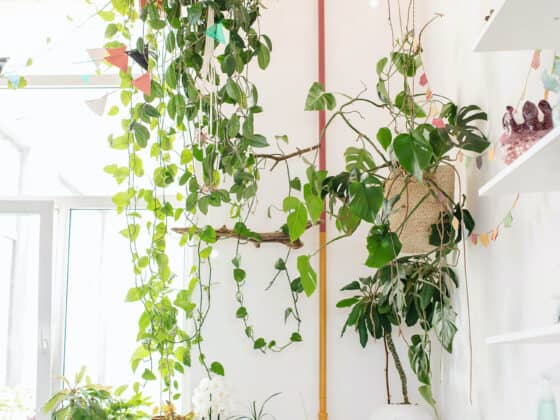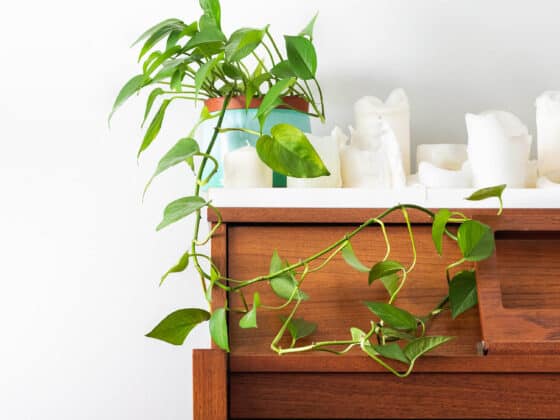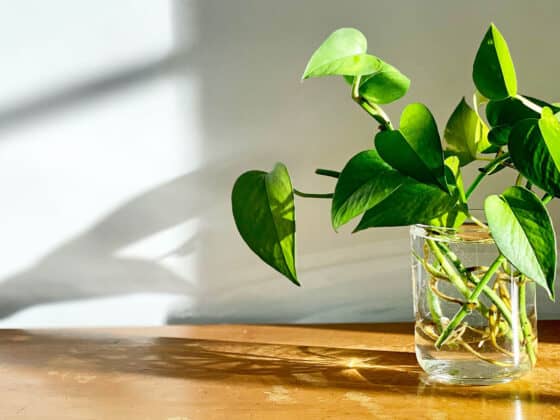Did you know that soil and water aren’t your only options for growing a Pothos? You can also use a fantastic soilless medium called LECA, which in some ways is the best of both worlds. You’ll need to know a few tricks to make it work right, but that’s why we’re here. This post will give you the full scoop on how to grow Pothos in LECA.
When you grow a Pothos in LECA, it’s much less susceptible to overwatering and root rot. Simply keep the container about ⅓ full of water and the pellets will wick it up to the roots. You’ll also have to provide small doses of hydroponic fertilizer every 4-6 weeks to keep your Pothos healthy.
Keep reading for our detailed how-to guide and our review of the pros and cons of LECA. We’ll also answer common questions like how to transfer your plants from soil and which containers work best. Ready to become an expert on growing Pothos in LECA? Let’s dive in!
What is LECA and Why Will Your Pothos Love It?
LECA has become very popular in certain online houseplant communities. But if you’re unfamiliar with it, here’s what you need to know.
LECA is an acronym for Lightweight Expanded Clay Aggregates. (You can see why the nickname is more popular.) It’s a sterile growing medium for plants, made up of small marble-sized balls of clay. These little chunks have been puffed up in a hot kiln, forming tons of tiny bubbles in the clay. This makes it light and porous.
Because of all these tiny gaps, LECA can act as a wick, transferring water to a plant’s roots. And each sphere can absorb and hold lots of moisture to keep a plant from going thirsty. That makes it ideal for a type of plant growth called semi-hydroponic or semi-hydro.
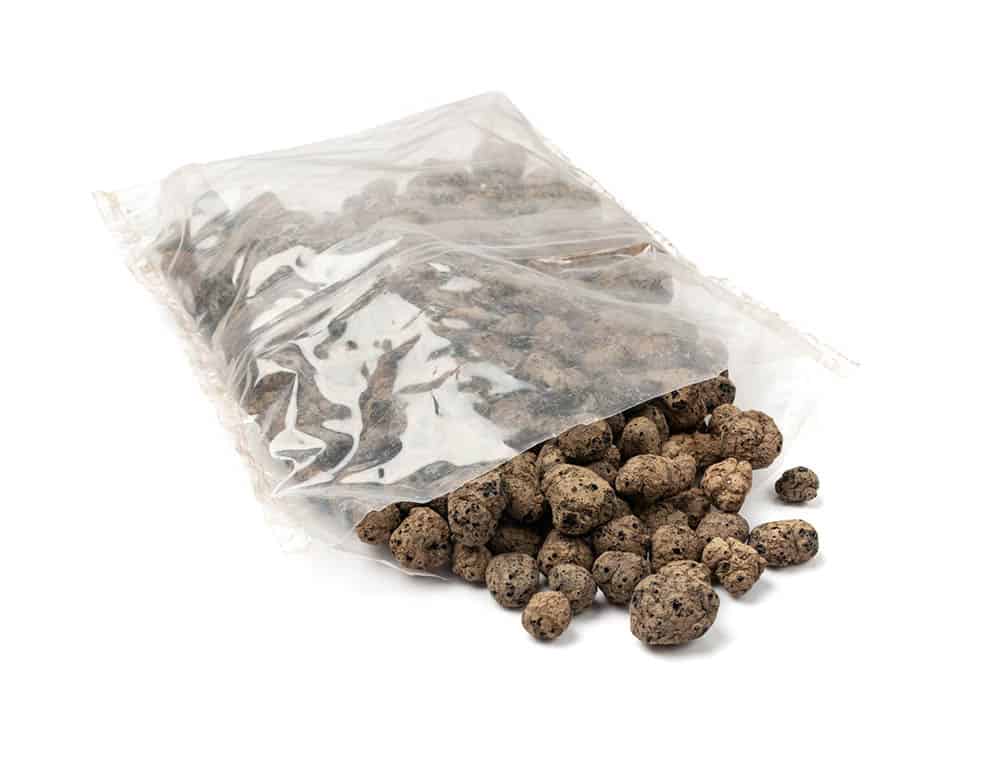
In this method, you fill a jar, vase, bucket, or some other container with LECA. There’s a reservoir of water at the base, while the plant sits at the top. The roots dig into the LECA but stay above the water line. The clay carries water up to the plant so it can stay hydrated.
Why is this better for a Pothos than soil? Here are the main advantages:
Pros of Growing a Pothos in LECA
Pro #1: Worry-Free Watering
Hydrating a Pothos (or any houseplant) normally requires a careful balance. You have to keep the roots damp without letting the soil get severely waterlogged. If you underdo it, your plant runs out of moisture, making it wilt and get crispy. If you overdo it, you could give your Pothos root rot, which might kill it completely.
You don’t have to walk this tightrope act when you grow a Pothos in LECA. As long as you keep the water reservoir full, the pebbles maintain an even level of moisture around the roots. And LECA won’t turn into clingy mush the way overwatered soil does. That means it won’t cut off the oxygen supply from the roots. Since overwatering is one of the biggest threats to a Pothos, removing this risk is a major plus.
Pro #2: Less Mess
When your plants are growing in potting mix, it’s hard to pot or transplant them without spilling a bit. LECA is much tidier. Sure, you might drop a couple of the clay balls on the floor, but it doesn’t spread out or get ground into your carpet the way soil does.
LECA is also much less prone to pest infestations. A lot of the bugs that attack houseplants live in the soil for at least a portion of their life cycles. But it’s not nearly as easy for them to set up shop in a sterile medium like LECA. Growing your Pothos semi-hydroponically won’t completely prevent pest problems, but it makes them quite a bit less likely.
Pro #3: You Can Reuse It
If you ever need to move your plant into a new pot (or if it dies), you don’t have to throw away the old LECA. You can use the same batch over and over again as many times as you want. It doesn’t decay like the organic materials that make up potting soil. Simply sterilize the pellets by boiling them in a pot of water, then reuse them.
Cons of Growing a Pothos in LECA
We’ve talked up the benefits of LECA for your Pothos, but you should be aware of the negatives too:
Con #1: Cost
LECA doesn’t come cheap. If you’re trying to switch a whole lot of plants to semi-hydro, be ready to shell out a decent amount of money. The fact that it’s reusable takes a bit of the sting out of this, but the up-front cost is still high.
The LECA itself isn’t the only expense, either. We’ll get into more detail on this later, but semi-hydroponic growing requires additional supplies like pH testing kits. And you won’t be able to use the typical containers you’d employ when growing your Pothos in potting mix. So you may also need to buy new pots, jars, or vases.
Con #2: Maintenance
LECA is a totally inorganic medium. So unlike compost, for example, it contains none of the nutrients necessary for a houseplant’s metabolism. When you grow a Pothos in LECA, you’ll have to supply fertilizer on a regular basis. You can’t mix it into the medium as you would with soil.
You’ll also have to regularly test the pH of your plant’s water. Potting soil has some buffering qualities that keep it in roughly the right range for a Pothos. The water in your semi-hydroponic reservoir doesn’t have the same advantage. So it may need to be adjusted periodically.
Because of these requirements, your Pothos needs frequent maintenance in LECA. It might also take you some time to figure out the precise dosage and frequency of fertilizer.
You’ll have to decide for yourself whether that’s an acceptable trade-off for the benefits we described above. For many people, the answer is a definite yes! You won’t have to look hard to find people online raving about how much healthier their plants are in LECA.
What You’ll Need to Grow a Pothos in LECA
The first step in becoming a semi-hydro master is to get your supplies together. Here’s what you’ll need on hand before you start:
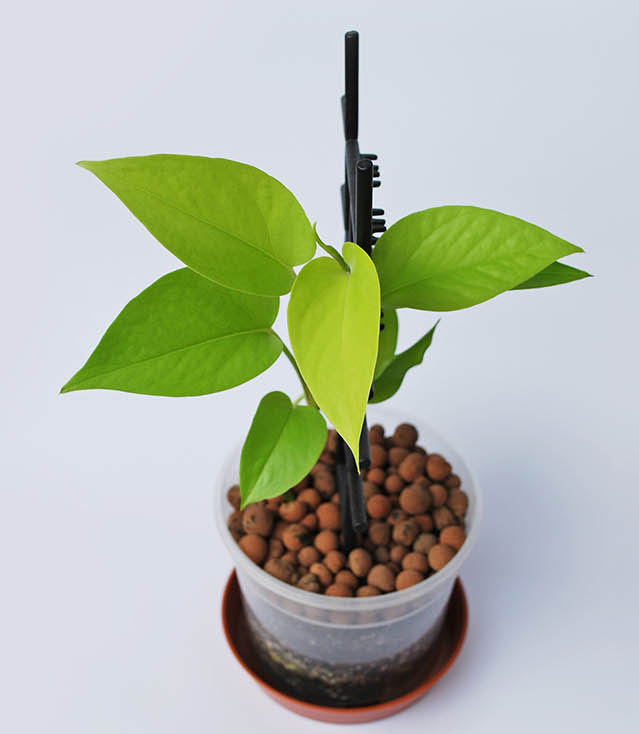
LECA
This is a no-brainer – you need LECA to grow in LECA! In our opinion, you can’t do better than the original brand that sparked the clay pebble craze. You’ll have to decide how much you need. A hefty 25-liter bag will last you a while, even if you’re planning on moving a lot of plants to LECA. If you just want to try it out and see how you like it, a 10-liter package should be plenty.
Fertilizer
We touched on this above, but plants grown in LECA need frequent doses of nutrients. You can’t count on ordinary houseplant fertilizer to get the job done, either. That stuff relies on chemical reactions in the soil to break down the nutrients for the roots to absorb. You need a hydroponic fertilizer that you can add directly to the water.
pH Kit
You’ll need a way to keep track of the pH of your water reservoir. We recommend this kit, which makes it simple to test and adjust the acidity. The ideal range for a Pothos plant is between 6.1 and 6.8.
Containers
To grow a Pothos in LECA, you need a container with a solid base. That rules out traditional houseplant pots, unless you plug up the drainage holes. It’s also helpful to pick a vessel with a wide mouth. That makes it much easier to refill the water supply and take your Pothos out of its pot when necessary.
Those requirements still leave you with a lot of options. Anything from a plain plastic bucket to an intricately detailed vase will work. We prefer clear glass containers because they make it simple to monitor the water level.
You may also want to get a net pot that can fit inside the bigger container that holds the water supply. This porous pot will hold the plant and the LECA. Your substrate will still be able to soak up moisture through the openings in the net pot, but you can easily lift it out when necessary. A more thrifty option is to cut some openings in a plastic pot you already have lying around. (Pro tip: old take-out containers are often great for this.)
Water
You don’t necessarily need special water to grow a Pothos in LECA. Most people use water from the tap with no issues. However, the water in some areas has a high mineral content or a problematic pH. If what’s coming out of your faucet is less than ideal for a Pothos, you could buy distilled water instead.
Rainwater is also good, since it usually contains small amounts of organic nutrients. It’s tough to guarantee you’ll be able to collect enough rain to keep your Pothos hydrated, though.
Moving a Pothos from Soil to LECA
Ready to grow a Pothos in LECA? Here’s how to get it set up.
Step 1: Clean and Soak Your LECA
If you’re using brand-new LECA, you’ll need to get it ready. There’s usually a fair amount of fine clay dust on the pebbles when they first arrive, which you should clean off. You don’t want it clouding the water in the reservoir. Rinse it off thoroughly.
It’s often a good idea to do this outside, so you’re not dumping a bunch of grit into your pipes. Either way, keep the water going until it’s clear instead of reddish-brown when it flows out.
Next, place the LECA in a large bowl or tub of water. Let them soak for 24 hours to absorb as much water as possible. This will ensure there’s plenty of moisture for your Pothos to drink once you transfer it. It also keeps you from overfilling your container – LECA can swell up to five times its dry size!
Step 2: Prepare Your Water
Add some of your hydroponic nutrients to the water you’re giving your Pothos. The packaging will have directions explaining how many drops per liter to add. We recommend making a ¼-strength mix at first. A newly transplanted Pothos won’t need much extra nutrition, and overdoing it could hurt your plant.
Next, test the pH of the nutrient solution you’ve created. Is it outside the 6.1-6.8 range that Pothos plants prefer? If so, get it into the right zone using the “pH Up” or “pH Down” solutions in your kit. This is good practice for future refills.
Step 3: Fill the Pot
Add LECA to your container until it’s between ⅓ and ⅔ full, then pour in some of your nutrient mix. It’s generally best for the water line to come ⅓ of the way up the pot.
However, you can tweak this a little bit depending on the size and shape of the container. The point is to leave enough room so that the roots of your Pothos won’t touch the liquid. The LECA should act as a moisture-wicking buffer between the plant and its water supply. If the roots trail down into the reservoir, they could suffocate and rot.
Step 4: Transfer Your Pothos
Uproot your plant gently, tilting the pot over and sliding it out. You might have to smack the bottom of the planter a few times to loosen it up. Once it’s out, remove the soil from its roots, rinsing if necessary. Thoroughness is important here – you want as little soil as possible contaminating your clay. The advantages of growing a Pothos in LECA come from the fact that it’s a uniform, sterile medium.
After the roots are nice and clean, nestle them on top of the LECA in its new container. Then gently add more pellets until the plant is buried to the same level as it was in the soil. It’s often helpful to jostle the container to help the LECA settle in place.
Going slow and steady is the key to making this step work. Your Pothos won’t be happy if you snap a bunch of its roots.
Step 5: Let Your Pothos Rest
Transplanting is very stressful for your plant. Move it someplace where it won’t be exposed to direct sunlight. That doesn’t mean keep it in the dark – your Pothos still needs bright, indirect light to thrive. Just make sure the sun’s rays can’t hit it head-on. The temperature in your plant’s location should be between 65 and 85 degrees.
Even in the perfect location, your Pothos will probably wilt for at least a few days after its ordeal. It may even lose some leaves. Don’t panic. Give it some time to adjust, and your Pothos should revive in a week or two at the most.
Caring For Your Pothos While It’s Growing in LECA
Once your Pothos is established in its LECA jar, your main task is to manage its water supply. Check on it once a week and top it off when it starts to run low. It’s also a good idea to completely dump out the reservoir and refill it every 2-4 weeks. This will keep it from getting stagnant.
During the growing season, you should add a fresh dose of nutrients when changing the water. The guidelines that come with your fertilizer kit will give you an idea of how much to supply. However, it’s better to err on the side of too little fertilizer than too much. An excess of nutrients can damage the roots. This is also why you don’t fertilize in the fall or winter.
The mineral salts from your fertilizer solution may form a whitish crust on the LECA. It’s a good idea to clear this off by running a large amount of water through the root system. This is easy if you’re using a net pot – just take it out and rinse it in the sink. If not, you’ll have to repeatedly refill and empty the reservoir until the crust washes away.
Finally, remember to test the pH of the water when you’re preparing a fresh batch to refill the reservoir. You might also want to give the water sitting in the container an occasional checkup. It should be pretty simple to calibrate this – just refer to the directions in your pH kit.
Can Your Pothos Grow in Just Water?
Maybe you’ve seen pictures of houseplants growing in jars of pure water. And maybe you’re wondering if that will work for your plant. Do you need to grow a Pothos in LECA, or can you cut out the middleman and use plain water?
The answer is yes, you can absolutely grow a Pothos in water. We even have a how-to guide here. The main reason to opt for LECA is to provide some structure for your Pothos’s roots. They’ll grow larger and stronger when they have something to grip. They’ll also have more oxygen to fuel their growth. Your plant can create special water-breathing roots, but they’re more fragile than soil and air roots.
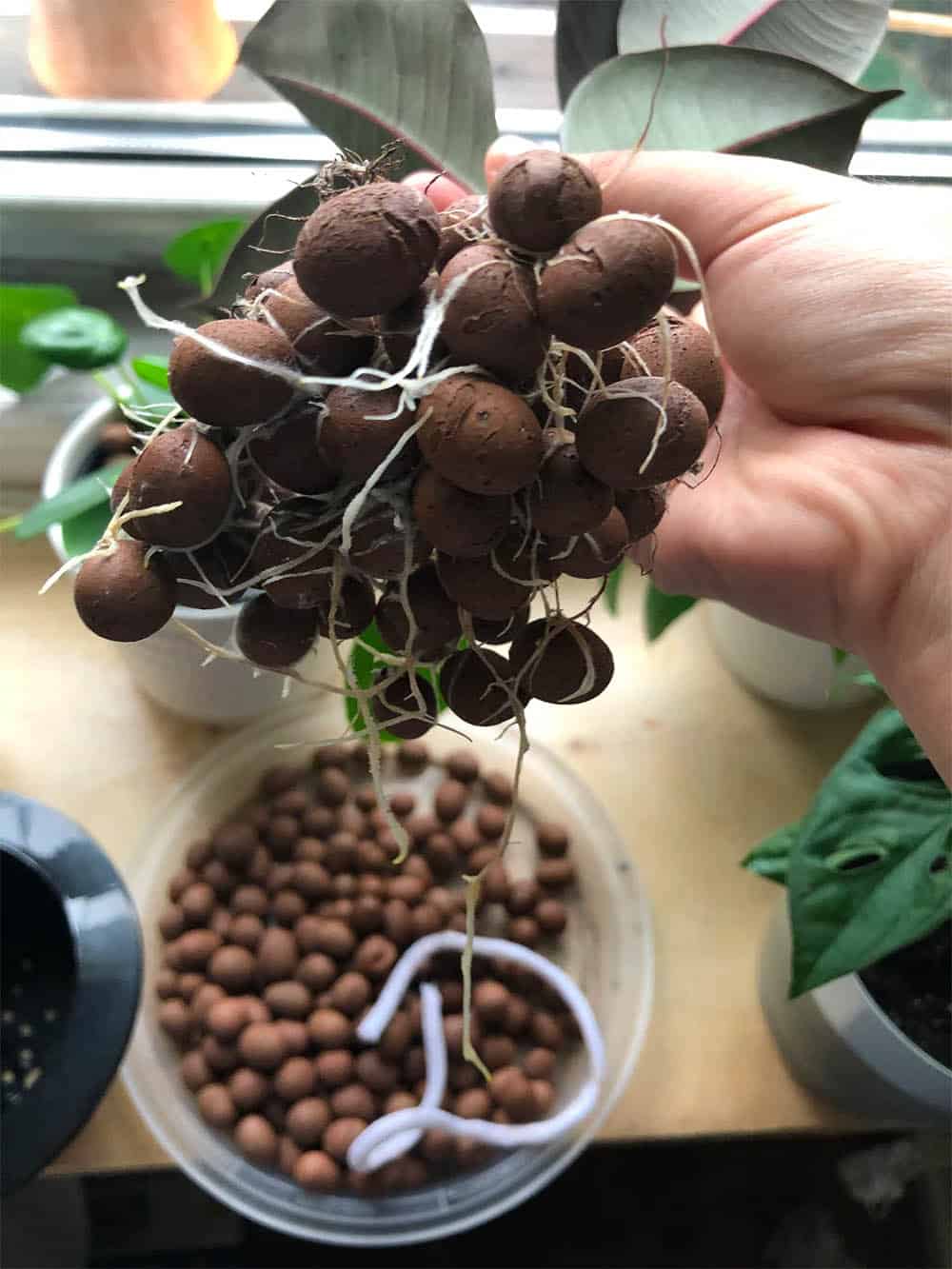
How much difference will this make to your plant’s overall health? It’s difficult to say, though your Pothos will usually grow a bit faster in LECA than in pure water.
If you’re starting with a large, well-established plant, it’s easier to move it to a semi-hydroponic system. Placing it in pure water will require it to replace its entire existing root system with water roots. A good deal of foliage often dies off in the process. When raising a Pothos in water, it’s usually better to grow a new plant from leaf cuttings.
Final Thoughts
Trying to grow a Pothos in LECA takes some adjustment – for you and for your plant. However, once you get the hang of it, you may find that it makes your job as a plant parent much easier. At the very least, it’s a fun and interesting experiment! We hope your Pothos loves its new LECA-filled home.






